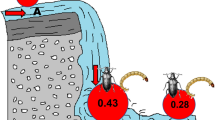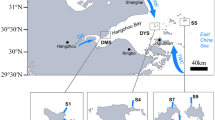Abstract
The aquatic macrofauna of the Guadalquivir estuary were sampled (1 mm mesh persiana net) at 5 sampling sites located along the entire (except the tidal freshwater region) estuarine gradient of salinity (outer 50 km). A total of 134 fish and macroinvertebrate species was collected but only 62 were considered common or regularly present in the estuary. Univariate measures of the community structure showed statistically significant differences among sampling sites: species richness, abundance, and biomass decreased in the upstream direction, being positively correlated with the salinity. Temporal differences of these three variables were also statistically significant. While a clear seasonal pattern (minimum densities in winter and maximum in spring-summer) was observed for abundance and biomass, no such pattern existed for the number of species. Mysids was the most dominant group throughout the estuary (96% to 99% of abundance; 49% to 85% of biomass), although fish biomass was also important at the outer estuary (36% to 38%). Multivariate analyses indicated highly significant spatial variation in the macrofaunal communities observed along the salinity gradient. These analyses suggest that the underlying structure was a continuum with more or less overlap** distributions of the species dependent on their ability to tolerate different physicochemical conditions. There were also significant temporal (intermonthly + interannual) variation of the estuarine community; the relative multivariate dispersion indicated that monthly variation was more considerable (relative multivariate dispersion >1) at the outer part of the estuary during the wet year (last 20 km) and was higher in the inner stations during the dry year (32 to 50 km from the river mouth). Since a clear negative exponential relationship was observed between the freshwater input (from a dam located 110 km upstream) and water salinity at all sampling stations, it is concluded that the human freshwater management is probably affecting the studied estuarine communities. While the higher seasonal (long-term) stability of the salinity gradient, due to the human control of the freshwater input, may facilitate the recruitment of marine species juveniles during the meteorologically unstable early-spring, the additional (short-term) salinity fluctuations during the warm period may negatively affect species that complete their lifecycle within the estuary.
Similar content being viewed by others
Literature Cited
Arias, A. M. andP. Drake. 1990. Estados juveniles de la ictiofauna en los caños de las salinas de la Bahía de Cádiz. Junta de Andalucía and Consejo Superior de Investigaciones Científicas, Cádiz.
Arndt, E. A. andW. Jansen. 1986.Neomysis integer (Leach) in the chain of boddens south of darss/zinst (western Baltic)—Ecophysiology and population dynamics.Ophelia 4:1–15.
Aziteiro, U. M. M., L. Jesus, andJ. C. Marques. 1999. Distribution, population dynamics, and production of the suprabenthic mysidMesopodopsis slabberi in the Mondego estuary, Portugal.Journal of Crustacean Biology 19:498–509.
Baluja, G., J. González, C. Rico, andL. M. Hernández. 1985. Sources and transport of organochlorine compounds and heavy metals into waters of the National Park of Doñana.Bulletin of Environmental Contamination and Toxicology 35:482–489.
Barnes, R. S. K. 1989. What, if anything, is the brackish-water fauna?Transactions of the Royal Society of Edinburg, Earth Sciences 80:235–240.
Beukema, J. J. 1992. Dynamics of juvenile shrimpCrangon crangon in a tidal-flat nursery of the Wadden Sea after mild and cold winters.Marine Ecology Progress Series 83:157–165.
Blaber, S. J. M., D. T. Brewer, andJ. P. Salini. 1989. Species composition and biomasses of fishes in different habitats of a tropical northern Australian estuary: Their occurrence in the adjoining sea and estuarine dependence.Estuarine, Coastal and Shelf Science 29:509–531.
Cabral, H. andM. J. Costa. 1999. Differential use of nursery areas within the Tagus estuary by sympatric soles,Solea solea andSolea senegalensis.Environmental Biology of Fish 56:389–397.
Cabrera, F., M. Soldevilla, R. Cordón, andP. Arambarri. 1987. Heavy metal pollution in the Guadiamar River and the Guadalquivir estuary (South West Spain).Chemosphere 16:463–468.
Castel, J. 1993. Long-term distribution of zooplankton in the Gironde estuary and its relation with river flow and suspended matter.Cahiers de Biologie Marine 34:45–163.
Cattrijsse, A., E. S. Makwaia, H. R. Dankwa, O. Hamerlynck, andM. A. Hemminga. 1994. Nekton communities of an intertidal creek of a European estuarine brackish marsh.Marine Ecology Progress Series 109:195–208.
Clark, J. R. 1992. Integrated management of coastal zones. Fisheries Technical Paper, 327, Food and Agriculture Organization, United Nations, Rome, Italy.
Clarke, K. R. 1993. Non-parametric multivariate analysis of changes in community structure.Australian Journal of Ecology 18:117–143.
Clarke, K. R. andR. H. Green. 1988. Statistical design and analysis for a “biological effects” study.Marine Ecology Progress Series 46:213–226.
Clarke, K. R. andR. M. Warwick. 1994. Change in Marine Communities: An Approach to Statistical Analysis and Interpretation. Natural Environment Research Council, U.K.
Costa, M. J. 1988. The Tagus and Mira estuaries (Portugal) and their role as spawning and nursery areas.Journal of Fish Biology 33:249–250.
Costa, M. J. andA. Bruxelas. 1989. The structure of fish communities in the Tagus estuary, Portugal, and its role as a nursery for commercial fish species.Scientia Marina 53:561–566.
Cunha, M. R., J. C. Sorbe, andM. H. Moreira. 1999. Spatial and seasonal changes of brackish peracaridan assemblages and their relation to some environmental variables in two tidal channels of the Ria de Aveiro (NW Portugal).Marine Ecology Progress Series 190:69–87.
Drake, P. andA. M. Arias. 1991a. Composition and seasonal fluctuations of the ichthyoplankton community in a shallow tidal channel of the Cádiz Bay (Spain).Journal of Fish Biology 39:245–263.
Drake, P. andA. M. Arias. 1991b. Ichthyoplankton of a shallow coastal inlet in south-west Spain: Factors contributing to colonization and retention.Estuarine, Coastal and Shelf Science 32:347–364.
Drake, P., A. M. Arias, andM. Conradi. 1997. Aportación al conocimiento de la macrofauna supra y epibentónica de los caños mareales de la Bahía de Cádiz (España).Publicaciones Especiales del Instituto Español de Oceanografía 23:133–141.
Drake, P., F. Baldó, J. A. Cuesta, D. García-González, A. Silva-García, A. M. Arias, A. Rodríguez, I. Sobrino, andC. Fernández-Delgado. 1999. Initial effects of the toxic waste spill (Aznalcóllar mine accident) on the aquatic macrofauna of the Guadalquivir estuary.The Science of the Total Environment 242:271–280.
Elliott, M. andE. Dewailly. 1995. Structure and components of European estuarine fish assemblages.Netherlands Journal of Aquatic Ecology 29:397–417.
Elliott, M., M. G. O'Reilly, andC. J. L. Taylor. 1990. The Forth estuary: A nursery and overwintering area for North Sea fishes.Hydrobiologia 195:89–103.
Fernández-Delgado, C. 1987. Ictiofauna del Estuario del Guadalquivir: Su distribución y biología de las especies sedentarias. Ph.D. Universidad of Córdoba, Sevilla, Spain.
Fernandez-Delgado, C., P. Drake, A. M. Arias, andD. García-González. 2000. Peces de Doñana y su entorno. Organismo Autónomo Parques Nacionales, Ministerio de Medio Ambiente, Madrid, Spain.
Field, J. G., K. R. Clarke, andR. M. Warwick. 1982. A practical strategy for analysing multispecies distribution patterns.Marine Ecology Progress Series 8:37–52.
Gelin, A., A. J. Crivelli, E. Rosecchi, andP. Kerambrun 2001. Can salinity changes affect reproductive success in the brown shrimpCrangon crangon? Journal of Crustacean Biology 21:905–911.
González-Arteaga, J. 1993. Las Marismas del Guadalquivir: Etapas de su aprovechamiento económico. Ed. C.P. Antonio Cuevas y Excmo. Ayuntamiento de la Puebla del Río.
Greenwood, J. G., M. B. Jones, andJ. Greenwood. 1989. Salinity effects on brood maduration of the mysid crustaceanMesopodopsis slabberi.Journal of the Marine Biological Association of the United Kingdom 69:683–694.
Grimalt, J. O., M. Ferrer, andE. Macpherson. 1999. The mine tailing accident in Aznalcollar.The Science of the Total Environment 242:3–11.
Kuipers, B. R. andR. Dapper. 1984. Nursery function of Wadden Sea tidal flats for the brown shrimpCrangon crangon.Marine Ecology Progress Series 17:171–181.
Lenaton, R. C. J. 1982. Alternative non-estuarine nursery habitats for some commercially and recreationally important fish species of south-western Australia.Australian Journal of Marine and Freshwater Research 33:881–900.
Maes, J., P. A. van Damme, A. Taillieu, andF. Ollevier. 1998a. Fish communities along an oxygen-poor salinity gradient (Zeeschelde estuary, Belgium).Journal of Fish Biology 52:534–546.
Maes, J., A. Taillieu, P. A. van Damme, K. Cottenie, andF. Ollevier. 1998b. Seasonal patterns in the fish and crustacean community of a turbid temperate estuary (Zeeschelde estuary, Belgium).Estuarine, Coastal and Shelf Science 47:143–151.
Marchand, J. 1980. Distribution saisonnière, abondance et diversité de l'ichtyofaune de l'estuaire interne de la Loire.Annales du Institute de Océanographic de Paris 56:127–137.
Marshall, S. andM. Elliott. 1998. Environmental influences on the fish assemblage of the Humber estuary, U.K.Estuarine, Coastal and Shelf Science 46:175–184.
Mees, J., A. Dewicke, andO. Hamerlynck. 1993. Seasonal composition and spatial distribution of hyperbenthic communities along estuarine gradients in the Westerschelde.Netherlands Journal of Aquatic Ecology 27:359–376.
Mees, J. andO. Hamerlynck. 1992. Spatial community structure of the winter hyperbenthos of the Schelde estuary, The Netherlands, and the adjacent coastal waters.Netherlands Journal of Sea Research 29:357–370.
Moffat, A. M. andM. B. Jones. 1992. Bionomics ofMesopodopsis slabberi andNeomysis integer (Crustacea: Mysidacea) in the Tamar estuary, p. 109–119.In V. J. Köhn, M. B. Jones, and A. M. Moffat (eds.), Taxonomy, Biology and Ecology of (Baltic) Mysids. Rostock University Press, Rostock, Germany.
Moreira, M. H., H. Queiroga, M. M. Machado, andM. R. Cunha. 1993. Environmental gradients in a southern Europe estuarine system: Ria Aveiro, Portugal. Implications for soft bottom macrofauna colonization.Netherlands Journal of Aquatic Ecology 27:465–482.
Peterson, M. S. andS. T. Ross. 1991. Dynamics of littoral fishes and decapods along a coastal river-estuarine gradient.Estuarine, Coastal and Shelf Science 33:467–483.
Potter, I. C., P. N. Claridge, G. A. Hyndes, andK. R. Clarke. 1997. Seasonal annual and regional variations in ichthyofaunal composition in the Inner Severn estuary and Inner Bristol Channel.Journal of the Marine Biological Association of the United Kingdom 77:507–525.
Potter, I. C., P. N. Claridge, andR. M. Warwick. 1986. Consistency of seasonal changes in an estuarine fish assemblages.Marine Ecology Progress Series 32:217–228.
Rakocinski, C. F., D. M. Baltz, andJ. W. Fleeger. 1992. Correspondence between environmental gradients and the community structure of marsh-edge fishes in a Louisiana estuary.Marine Ecology Progress Series 80:135–148.
Remane, A. 1934. Die Brackwasserfauna.Verhandlungen der Deutschen Zoologischen Gesellschaft 36:37–74.
Sorbes, J. C. 1981. La macrofaune vagile de l'estuaire de la Gironde: Distribution et migration des espèces, modes de reproduction, régimes alimentaires.Oceanis 6:579–592.
Thiel, R., A. Sepúlveda, R. Kafemann, andF. Nellen. 1995. Environmental factors as forces structuring the fish community of the Elbe Estuary.Journal of Fish Biology 46:47–49.
Valesini, F. J., I. C. Potter, M. E. Platell, andG. A. Hyndes. 1997. Ichthyofaunas of a temperate estuary and adjacent marine embayment. Implications regarding choice of nursery area and influence of environmental changes.Marine Biology 128:317–328.
Vannéy, J. R. 1970. L'hydrologie du bas Guadalquivir. Instituto de Geografía aplicada del Patronato “Alonso de Herrera.” Madrid, Spain.
Wagner, C. M. 1999. Expression of the estuarine species minimum in littoral fish assemblages of the lower Chesapeake Bay tributaries.Estuaries 22:304–312.
Wagner, C. M. andH. M. Austin. 1999. Correspondence between environmental gradients and summer littoral fish assemblages in low salinity reaches of the Chesapeake Bay, USA.Marine Ecology Progress Series 177:197–212.
Walsh, C. J. andB. D. Mitchell. 1998. Factors associated with variations in abundance of epifaunal caridean shrimps and within estuarine seagrass meadows.Marine and Freshwater Research 49:769–777.
Whitfield, A. K. 1989. Ichthyoplankton in a southern African surf zone: Nursery area for the postlarvae of estuarine associated fish species?Estuarine, Coastal and Shelf Science 29:533–547.
Young, G. C., I. C. Potter, G. A. Hyndes, andS. de Lestang. 1997. The ichthyofauna of an intermittently open estuary: Implications of bar breaching and low salinities on faunal composition.Estuarine, Coastal and Shelf Science 45:53–68.
Author information
Authors and Affiliations
Corresponding author
Rights and permissions
About this article
Cite this article
Drake, P., Arias, A.M., Baldó, F. et al. Spatial and temporal variation of the nekton and hyperbenthos from a temperate European estuary with regulated freshwater inflow. Estuaries 25, 451–468 (2002). https://doi.org/10.1007/BF02695987
Received:
Accepted:
Issue Date:
DOI: https://doi.org/10.1007/BF02695987




